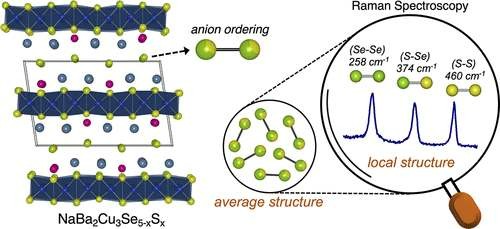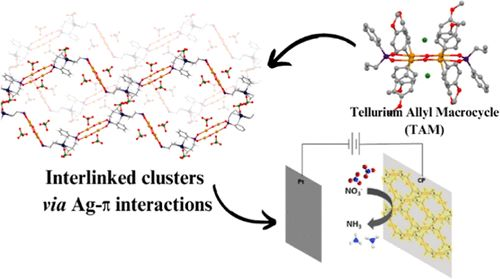
Inorganic Chemistry
@inorgchem
Editor-in-Chief Stefanie Dehnen and the IC team bring you fundamental studies on all topics of inorganic chemistry from across the Periodic Table.
ID: 583802897
http://pubs.acs.org/IC 18-05-2012 13:23:47
11,11K Tweet
33,33K Followers
301 Following


More great Inorganic Chemistry from across the Periodic Table! This week the cover accompanies an article by IC AE Partha Mukherjee and coauthors describing the synthesis of catenated cages for the selective separation of coal tar planar aromatic molecules: go.acs.org/arj


New in Inorganic Chemistry: Quaternary chalcogenides with site ordering in their mixed-anion compositions by Ayat Tassanov et al. Penn State Chemistry James Hodges, Portland State University. Read it here: pubs.acs.org/doi/10.1021/ac…


Discover a brand-new home for your work: ACS Electrochemistry Drop by the ACS Publications booth at #ACSFall2024 in Denver, CO to learn more and meet our friendly staff. Register now:



New in Inorganic Chemistry: @Esteruelasgroup, Javier A. Cabeza, and Israel Fernández Group show that a bare lead atom is capable of linearly bond and stabilize two units of a classical osmium polyhydride complex: pubs.acs.org/doi/10.1021/ac…



More great Inorganic Chemistry from across the Periodic Table! This week the cover accompanies an article by IC AE Roberta Sessoli and coauthors describing EPR studies of metalloporphyrins coupled with {Cr7Ni} rings: doi.org/10.1021/acs.in…


Just getting off to a great start at the INORG Lectureship award seminar at ACS Fall Meeting in Mile High Ballroom 2C in Denver! IC EIC Stefanie Dehnen moderating. Inorganic Chemistry


Inorganic Chemistry congratulates Prof. Daniel Suess of MIT for receiving the 2024 Inorganic Chemistry Lectureship Award presented at the ACS Fall Meeting in Denver by EIC Stefanie Dehnen! Stefanie Dehnen


Precision Control of Amphoteric Doping in CuxBi2Se3 Nanoplates By Xiangfeng Duan et al UCLA Chem & Biochem Fully open access #ACSEditorsChoice in Precision Chemistry 👉 go.acs.org/ay3


New in Inorganic Chemistry: TM alumylene complexes featuring the Al(I)–H unit. Check out the report from Hashimoto (Hashimoto Lab (Tohoku Univ.)) & Ichitsubo groups, showing XRD structures and XPS study: go.acs.org/aCA



In Inorganic Chemistry now! "Uranium Chemistry: Identifying the Next Frontiers", a Viewpoint by Eralie, Ducilon and Gorden highlights recent developments in uranium chemistry from the last 15 years while considering key areas for future research: go.acs.org/aDf


Now in Inorganic Chemistry: Alkalis? Alkaline earths? Rare earths? Actinides? #Polyoxometalates do it all! A versatile chelating platform for a wide range of metal ions: go.acs.org/aDQ Lawrence Livermore National Laboratory Glenn T. Seaborg Institute at LLNL Funded by DOE Office of Science NNSA #POMNews #heavy_elements


Only in Inorganic Chemistry: Read how Au(III) tripyrrindione reacts with dichloromethane upon reduction to form cyclometalated organo-Au(III) complex in the new article by Elisa Tomat, Abhik Ghosh, Brent Nannenga and teams: go.acs.org/aFF


More great Inorganic Chemistry from across the Periodic Table! This week the cover accompanies an article describing the synthesis and characterization of a diiron complex showing electrocatalytic hydrogen evolution activity in various organic acids: go.acs.org/aFT


Only in Inorganic Chemistry: Charting a new way to Organometallic-Inorganic Hybrid materials by interlinking clusters via Ag-π interaction. This hybrid material acts as an excellent electrocatalyst for reduction of nitrate to ammonia: go.acs.org/aHf Baskar@UoH, Calvin Samuel



Only in Inorganic Chemistry: How do three Chinese dragons (hydrocarbon chains) dance together? In the form of two long alkyl chains aligning in parallel while the third one extends alone as present in Sb(SCnH2n+1)3 (n≥12) molecules. See it here: go.acs.org/aIH


![Inorganic Chemistry (@inorgchem) on Twitter photo Li et al. study the Prins cyclization reaction catalyzed by [Ga4L6]12− using molecular dynamics simulation and DFT calculation. Please check out our #TOCoftheWeek: pubs.acs.org/doi/10.1021/ac… Li et al. study the Prins cyclization reaction catalyzed by [Ga4L6]12− using molecular dynamics simulation and DFT calculation. Please check out our #TOCoftheWeek: pubs.acs.org/doi/10.1021/ac…](https://pbs.twimg.com/media/GU3VC5hX0AAJF1e.jpg)

![Inorganic Chemistry (@inorgchem) on Twitter photo Colliard and Deblonde present 25 new compounds with Keggin-derived ligands, forming a consistent base formula of Csx[M(XW11O39)2]·nH2O. Check out our #TOCoftheWeek: go.acs.org/aD3 Colliard and Deblonde present 25 new compounds with Keggin-derived ligands, forming a consistent base formula of Csx[M(XW11O39)2]·nH2O. Check out our #TOCoftheWeek: go.acs.org/aD3](https://pbs.twimg.com/media/GWJumWCXYAAQxA8.png)
